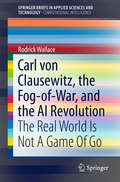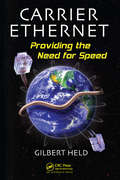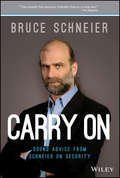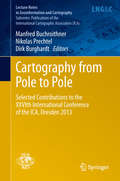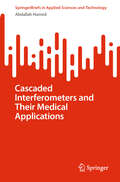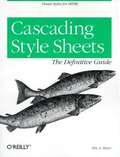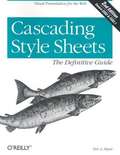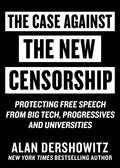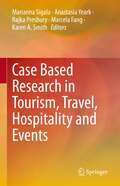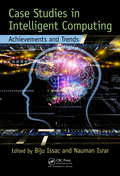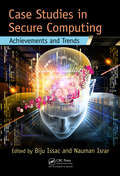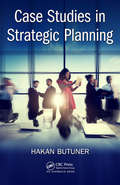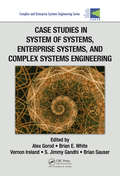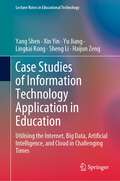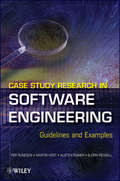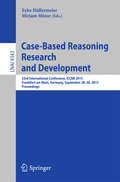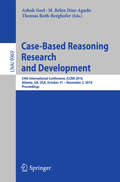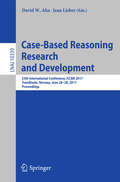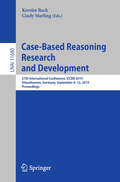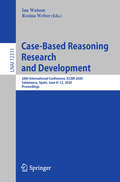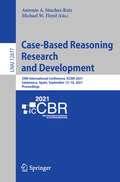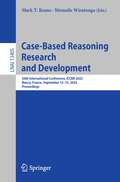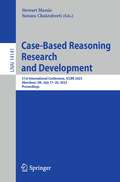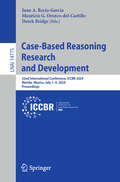- Table View
- List View
Carl von Clausewitz, the Fog-of-War, and the AI Revolution: The Real World Is Not A Game Of Go (SpringerBriefs in Applied Sciences and Technology)
by Rodrick WallaceThe language of business is the language of dreams, but the language of war is the language of nightmare made real. Yet business dreams of driverless cars on intelligent roads, and of other real-time critical systems under the control of algorithmic entities, have much of war about them. Such systems, including military institutions at the tactical, operational and strategic scales, act on rapidly-shifting roadway topologies whose 'traffic rules' can rapidly change. War is never without both casualty and collateral damage, and realtime critical systems of any nature will inevitably partake of fog-of-war and frictional challenges almost exactly similar to those that have made warfare intractable for modern states. Into the world of Carl von Clausewitz, John Boyd, Mao Tse-Tung, Vo Nguyen Giap and Genghis Khan, come the brash, bright-eyed techies of Alphabet, Microsoft, Amazon, and Uber who forthrightly step in where a phalanx of angels has not feared to tread, but treaded badly indeed. In this book we use cutting-edge tools from information and control theories to examine canonical and idiosyncratic failure modes of real-time cognitive systems facing fog-of-war and frictional constraints. In sum, nobody ever navigates, or can navigate, the landscapes of Carl von Clausewitz unscathed.
Carrier Ethernet: Providing the Need for Speed
by Gilbert HeldFacilitating high data transfers over long distances at a reasonable cost, Carrier Ethernet is solidifying its fundamental position as the core of next-generation networks. Since it first dazzled the IT world 40 years ago with its ability to move data over local networks, Ethernet has dramatically evolved in both form and function. And now, Carrier
Carry On
by Bruce SchneierUp-to-the-minute observations from a world-famous security expert Bruce Schneier is known worldwide as the foremost authority and commentator on every security issue from cyber-terrorism to airport surveillance. This groundbreaking book features more than 160 commentaries on recent events including the Boston Marathon bombing, the NSA's ubiquitous surveillance programs, Chinese cyber-attacks, the privacy of cloud computing, and how to hack the Papal election. Timely as an Internet news report and always insightful, Schneier explains, debunks, and draws lessons from current events that are valuable for security experts and ordinary citizens alike. Bruce Schneier's worldwide reputation as a security guru has earned him more than 250,000 loyal blog and newsletter readers This anthology offers Schneier's observations on some of the most timely security issues of our day, including the Boston Marathon bombing, the NSA's Internet surveillance, ongoing aviation security issues, and Chinese cyber-attacks It features the author's unique take on issues involving crime, terrorism, spying, privacy, voting, security policy and law, travel security, the psychology and economics of security, and much more Previous Schneier books have sold over 500,000 copies Carry On: Sound Advice from Schneier on Security is packed with information and ideas that are of interest to anyone living in today's insecure world.
Cartography from Pole to Pole: Selected Contributions to the XXVIth International Conference of the ICA, Dresden 2013 (Lecture Notes in Geoinformation and Cartography #8)
by Dirk Burghardt Manfred Buchroithner Nikolas PrechtelThis volume comprehends a selection of papers presented during the 26th International Cartographic Conference held in Dresden from the 26th to the 30th of August 2013. It covers many fields of relevant Mapping and GIS research subjects, such as cartographic applications, cartographic tools, generalisation and update Propagation, higher dimensional visualisation and augmented reality, planetary mapping issues, cartography and environmental modelling, user generated content and spatial data infrastructure, use and usability as well as cartography and GIS in education.
Cascaded Interferometers and Their Medical Applications (SpringerBriefs in Applied Sciences and Technology)
by Abdallah HamedThis book looks at the application of cascaded interferometers in both theoretical and practical contexts, particularly focusing on enhancing image contrast and facilitating medical diagnostics. Commencing with a comprehensive exploration of modulated two-beam interference employing Fourier optics, it progresses to discuss the implementation of a cascaded Michelson interferometer, with a specialized emphasis on its utility in analyzing microscopic structures such as glass fibers. Subsequent chapters examine step-index fibers using multiple laser beam interferometry and introduce sophisticated models for interpreting fringe shifts in unclad glass fibers through ordinary multiple-beam interference. Moreover, the book addresses the recognition of modulated apertures employing a Cascaded Fabry-Perot Interferometer (CFPI) and discusses its implications for various applications. It looks at the processing of retinal artery images leveraging higher orders of two-beam interference and investigates the utility of cascaded interferometric techniques in examining kidney and colon images. Furthermore, it presents a novel approach to image processing of coronaviruses utilizing interferometry techniques, showcasing the potential of interferometric methods in medical research and diagnostics. Through its systematic exploration of cascaded interferometers and their diverse applications, this book is suited for researchers, practitioners, and students alike, offering insights into both fundamental principles and advanced methodologies in interferometry and medical imaging.
Cascading Style Sheets: The Definitive Guide
by Eric MeyerCascading Style Sheets (CSS) is the HTML 4.0-approved method for controlling visual presentation on web pages. This comprehensive guide to CSS and CSS1 explores in detail each property, how individual properties interact, how to avoid common mistakes in interpretation. For both beginning and advanced web authors, this is the first major CSS title to address actual current browser support, rather than the way things work in theory.
Cascading Style Sheets: The Definitive Guide
by Eric MeyerCascading Style Sheets (CSS) is poised to make its mark on the Web. With good implementations in Internet Explorer 5.0 and Opera 3.6, and 100% support expected in Netscape's "Mozilla" browser, signs are that CSS is rapidly becoming a useful, reliable, and powerful tool for web authors. CSS is the W3C-approved method for enriching the visual presentation of web pages. Cascading Style Sheets: The Definitive Guide offers a complete, detailed review of CSS1 and CSS positioning, as well as an overview of CSS2. Each property is explored in detail with a discussion of how each interacts with other properties. There is also information on how to avoid common mistakes in interpretation. This book is the first major title to cover CSS in a way that both acknowledges and describes current browser support, instead of simply describing the way things work in theory. It offers both web authors and scripters a comprehensive guide to using CSS effectively. Cascading Style Sheets: The Definitive Guide targets veteran web authors who have already invested thousands of hours in learning HTML and writing web pages and are wondering why they need to learn a brand new language of style. This book supplies those dubious but curious web authors with the information they need to easily implement CSS for their web site. This book also addresses an audience of novice web authors who are already straining to learn all of the tags and attributes of HTML and can benefit now from implementing CSS correctly instead of repeating the mistakes of the past. The author has extensive experience writing about pitfalls and interesting tricks in CSS. He is a member of the CSS and FP Working Group, coordinates the W3C's CSS1 Test Suite, remains active on CSS newsgroups, and edits Web Review's Style Sheets Reference Guide. He has built a widespread reputation as a CSS expert, particularly with regard to his understanding of the intricacies of browser support for CSS. He brings his knowledge and expertise to this book in the form of hints, workarounds, and many other tips for web authors.
Cascading Style Sheets: The Definitive Guide, 2nd Edition
by Eric MeyerCascading Style Sheets: The Definitive Guide , 2nd Edition is a thorough review of all aspects of CSS2.1 and a comprehensive guide to CSS implementation. The book includes new content on positioning, lists and generated content, table layout, user interface, paged media, and more. It explores in detail each individual CSS property and how it interacts with other properties, and shows how to avoid common mistakes in interpretation.
Case Against the New Censorship: Protecting Free Speech from Big Tech, Progressives, and Universities
by Alan DershowitzIn The Case Against the New Censorship: Protecting Free Speech from Big Tech, Progressives, and Universities, Alan Dershowitz—New York Times bestselling author and one of America&’s most respected legal scholars—analyzes the current regressive war against freedom of speech being waged by well-meaning but dangerous censors and proposes steps that can be taken to defend, reclaim, and strengthen freedom of speech and other basic liberties that are under attack. Alan Dershowitz has been called &“one of the most prominent and consistent defenders of civil liberties in America&” by Politico and &“the nation&’s most peripatetic civil liberties lawyer and one of its most distinguished defenders of individual rights&” by Newsweek. He is also a fair-minded and even-handed expert on the Constitution and our civil liberties, and in this book offers his knowledge and insight to help readers understand the war being waged against free speech by the ostensibly well-meaning forces seeking to constrain this basic right. The Case Against the New Censorship is an analysis of every aspect of the current fight against freedom of speech, from the cancellations and deplatformings practiced by so-called progressives, to the powerful, seemingly arbitrary control exerted by Big Tech and social media companies, to the stifling of debate and controversial thinking at public and private universities. It assesses the role of the Trump presidency in energizing this backlash against basic liberties and puts it into a broader historical context as it examines how anti-Trump zealots weaponized, distorted, and weakened constitutional protections in an effort to &“get&” Trump by any means. In the end, The Case Against the New Censorship represents an icon in American law and politics exploring the current rapidly changing attitudes toward the value of free speech and assessing potential ways to preserve our civil liberties. It is essential reading for anyone interested in or concerned about freedom of speech and the efforts to constrain it, the possible effects this could have on our society, and the significance of both freedom of speech and the battle against it in a greater historical and political context.
Case Based Research in Tourism, Travel, Hospitality and Events
by Karen A. Smith Marianna Sigala Anastasia Yeark Rajka Presbury Marcela FangThis book consolidates international, contemporary and topical case study based research in tourism, travel, hospitality and events. Case studies can make learning more attractive and interesting as well as enable students to understand the theory better and develop their analytical and problem-solving skills. Using industry as an open living lab, case study based research infuses scholars into real-world industry challenges and inspires them to theorise and advance our knowledge frontiers.The book includes international case studies that can help tourism scholars build and advance (new) theories and enrich their educational practices. Case studies are accompanied with a teaching note guiding scholars to integrate case studies into instruction.Dr Kirsten Holmes, Chair, Council for Australasian Tourism and Hospitality Education (CAUTHE) There is a vital need for contemporary and well-structured case studies for use in tourism teaching. By including case studies from Australasia and key destination regions in Asia, Europe, and the Caribbean, the book is helpful for tertiary teachers globally. Professor Xander Lub, President, EuroCHRIE The book inspires educators and students. The cases provide context to students’ learning and demonstrate the richness and variation of the industry. The book also clearly demonstrates how research can inform our teaching. Professor Brian King, Chair, THE-ICE Assessment Panel The book includes cases under five themes: experiences, operations, technologies, strategy and marketing, and destinations. The book provides subject lecturers with a structure to guide students of applying theory into practice. Dr Paul Whitelaw, Academic Director, Southern Cross UniversityThis book marks a significant contribution to hospitality, tourism and events pedagogy at undergraduate and postgraduate level. At a time when the industry is demanding that our graduates have a strong grasp of “real world issues”, the case study approach provides an accessible, meaningful and relatable means by which students can engage in real world issues.
Case Studies in Intelligent Computing: Achievements and Trends
by Biju Issac Nauman IsrarAlthough the field of intelligent systems has grown rapidly in recent years, there has been a need for a book that supplies a timely and accessible understanding of this important technology. Filling this need, Case Studies in Intelligent Computing: Achievements and Trends provides an up-to-date introduction to intelligent systems.This edited book
Case Studies in Secure Computing: Achievements and Trends
by Biju Issac Nauman IsrarThis book gathers the latest research with case studies in secure computing from many researchers. It compiles the recent work and findings through case studies, where the growing security attacks and countermeasures in the mobile and networking world has been explained, along with other pertinent security issues with the technology of the application itself. It discusses the challenges faced and solutions proposed by different researchers in this area.
Case Studies in Strategic Planning
by Hakan ButunerCase Studies in Strategic Planning shows you how to do systematic strategic planning in real-life cases, regardless of your level of expertise. The simplified version of this methodology and its analysis tools, based on fundamentals, are easily understood and universally applied to any type of business for developing strategic plans. More important
Case Studies in System of Systems, Enterprise Systems, and Complex Systems Engineering (Complex and Enterprise Systems Engineering)
by Alex Gorod Brian E. White Vernon Ireland S. Jimmy Gandhi Brian SauserSuitable as a reference for industry practitioners and as a textbook for classroom use, Case Studies in System of Systems, Enterprise Systems, and Complex Systems Engineering provides a clear understanding of the principles and practice of system of systems engineering (SoSE), enterprise systems engineering (ESE), and complex systems engineering (C
Case Studies of Information Technology Application in Education: Utilising the Internet, Big Data, Artificial Intelligence, and Cloud in Challenging Times (Lecture Notes in Educational Technology)
by Sheng Li Yu Jiang Yang Shen Haijun Zeng Xin Yin Lingkai KongThis book includes 43 case studies showcasing the application of basic education informatization. It shares the experiences of 43 schools in the construction and application of educational informatization in various regions in China. It aims to promote the balanced development of education and expand the coverage of quality education resources. This book also highlights the achievements of these schools in constructing school-based resources, and changing teaching modes and optimizing classroom teaching. This collection of case studies not only reflects the current trend of informatization application moving from 'universal application' to 'integrated innovation' but also uncovers the potential of applying information technology to transform education processes, innovate education environment, and optimize education governance.
Case Study Research in Software Engineering
by Per Runeson Martin Höst Austen Rainer Björn RegnellBased on their own experiences of in-depth case studies of software projects in international corporations, in this book the authors present detailed practical guidelines on the preparation, conduct, design and reporting of case studies of software engineering. This is the first software engineering specific book on the case study research method.
Case-Based Reasoning Research and Development: 23rd International Conference, ICCBR 2015, Frankfurt am Main, Germany, September 28-30, 2015. Proceedings (Lecture Notes in Computer Science #9343)
by Eyke Hüllermeier Mirjam MinorThis book constitutes the refereed proceedings of the 23rd International Conference on Case-Based Reasoning Research and Development, ICCBR 2015, held in Frankfurt am Main, Germany, in September 2015. The 26 revised full papers presented were carefully reviewed and selected from 37 submissions. The papers cover a wide range of CBR topics that are of interest both to researchers and practitioners from foundations of Case-Based Reasoning; over CBR systems for specific tasks and related fields; up to CBR systems, applications and lessons learned in specific areas of expertise such as health; e-science; finance; energy, logistics, traffic; game/AI; cooking; diagnosis, technical support; as well as knowledge and experience management
Case-Based Reasoning Research and Development: 24th International Conference, ICCBR 2016, Atlanta, GA, USA, October 31 - November 2, 2016, Proceedings (Lecture Notes in Computer Science #9969)
by Ashok Goel, M Belén Díaz-Agudo and Thomas Roth-BerghoferThis book constitutes the refereed proceedings of the 24th International Conference on Case-Based Reasoning Research and Development, ICCBR 2016, held in Atlanta, GA, USA, in October/November 2016.The 14 revised full papers presented were carefully reviewed and selected from 44 submissions. The papers cover a wide range of CBR topics that are of interest both to researchers and practitioners from foundations of Case-Based Reasoning; over CBR systems for specific tasks and related fields; up to CBR systems, applications and lessons learned in specific areas of expertise such as health; e-science; finance; energy, logistics, traffic; game/AI; cooking; diagnosis, technical support; as well as knowledge and experience management.
Case-Based Reasoning Research and Development: 25th International Conference, ICCBR 2017, Trondheim, Norway, June 26-28, 2017, Proceedings (Lecture Notes in Computer Science #10339)
by David W. Aha Jean LieberThe 2001 International Conference on Case-Based Reasoning (ICCBR 2001, www. iccbr. org/iccbr01), the fourth in the biennial ICCBR series (1995 in Sesimbra, Portugal; 1997 in Providence, Rhode Island (USA); 1999 in Seeon, Germany), was held during 30 July - 2 August 2001 in Vancouver, Canada. ICCBR is the premier international forum for researchers and practitioners of case based reasoning (CBR). The objectives of this meeting were to nurture significant, relevant advances made in this field (both in research and application), communicate them among all attendees, inspire future advances, and continue to support the vision that CBR is a valuable process in many research disciplines, both computational and otherwise. ICCBR 2001 was the first ICCBR meeting held on the Pacific coast, and we used the setting of beautiful Vancouver as an opportunity to enhance participation from the Pacific Rim communities, which contributed 28% of the submissions. During this meeting, we were fortunate to host invited talks by Ralph Bergmann, Ken Forbus, Jaiwei Han, Ramon L#65533;pez de M#65533;ntaras, and Manuela Veloso. Their contributions ensured a stimulating meeting; we thank them all.
Case-Based Reasoning Research and Development: 27th International Conference, ICCBR 2019, Otzenhausen, Germany, September 8–12, 2019, Proceedings (Lecture Notes in Computer Science #11680)
by Cindy Marling Kerstin BachThis book constitutes the refereed proceedings of the 27th International Conference on Case-Based Reasoning Research and Development, ICCBR 2019, held in Otzenhausen, Germany, in September 2019. The 26 full papers presented in this book were carefully reviewed and selected from 43 submissions. 15 were selected for oral presentation and 11 for poster presentation. The theme of ICCBR 2019, "Explainable AI (XAI)," was highlighted by several activities. These papers, which are included in the proceedings, address many themes related to the theory and application of case-based reasoning and its future direction.
Case-Based Reasoning Research and Development: 28th International Conference, ICCBR 2020, Salamanca, Spain, June 8–12, 2020, Proceedings (Lecture Notes in Computer Science #12311)
by Ian Watson Rosina WeberThis book constitutes the refereed proceedings of the 28th International Conference on Case-Based Reasoning Research and Development, ICCBR 2020, held in Salamanca, Spain*, in June 2020. The 20 full papers and 2 short papers presented in this book were carefully reviewed and selected from 64 submissions. The theme of ICCBR 2020, “CBR Across Bridges” was highlighted by several activities. These papers, which are included in the proceedings, address many themes related to the theory and application of case-based reasoning and its future direction. *The conference was held virtually due to the COVID-19 pandemic.
Case-Based Reasoning Research and Development: 29th International Conference, ICCBR 2021, Salamanca, Spain, September 13–16, 2021, Proceedings (Lecture Notes in Computer Science #12877)
by Antonio A. Sánchez-Ruiz Michael W. FloydThis book constitutes the proceedings of the 29th International Conference on Case-Based Reasoning, ICCBR 2021, which took place in Salamanca, Spain, during September 13-16, 2021. The 21 papers presented in this volume were carefully reviewed and selected from 85 submissions. They deal with AI and related research focusing on comparison and integration of CBR with other AI methods such as deep learning architectures, reinforcement learning, lifelong learning, and eXplainable AI (XAI).
Case-Based Reasoning Research and Development: 30th International Conference, ICCBR 2022, Nancy, France, September 12–15, 2022, Proceedings (Lecture Notes in Computer Science #13405)
by Mark T. Keane Nirmalie WiratungaThis book constitutes the proceedings of the 30th International Conference on Case-Based Reasoning, ICCBR 2022, which took place in Nancy, France, during September 12-15, 2022.The theme of ICCBR 2022 was Global Challenges for CBR aiming to consider how CBR can and might contribute to challenges in sustainability, climate change, and global health. The 26 papers presented in this volume were carefully reviewed and selected from 68 submissions. They deal with AI and related research focusing on comparison and integration of CBR with other AI methods such as deep learning architectures, reinforcement learning, lifelong learning, and eXplainable AI (XAI).
Case-Based Reasoning Research and Development: 31st International Conference, ICCBR 2023, Aberdeen, UK, July 17–20, 2023, Proceedings (Lecture Notes in Computer Science #14141)
by Stewart Massie Sutanu ChakrabortiThis book constitutes the proceedings of the 31st International Conference on Case-Based Reasoning Research and Development, ICCBR 2023, which took place in Aberdeen, UK, in July 2023. The 26 full papers included in this book were carefully reviewed and selected from 79 submissions. The papers have been organized in topical sections as follows: CBR and deep learning; representation and similarity; CBR and explainable AI; case base maintenance; adaptation: techniques and application; and case-based applications.
Case-Based Reasoning Research and Development: 32nd International Conference, ICCBR 2024, Merida, Mexico, July 1–4, 2024, Proceedings (Lecture Notes in Computer Science #14775)
by Derek Bridge Juan A. Recio-Garcia Mauricio G. Orozco-del-CastilloThis book constitutes the refereed proceedings of the 32nd International Conference on Case-Based Reasoning Research and Development, ICCBR 2024, held in Merida, Mexico, during July 1–4, 2024. The 29 full papers included in this book were carefully reviewed and selected from 91 submissions. They cover a wide range of CBR topics of interest both to practitioners and researchers, including: improvements to the CBR methodology itself: case representation, similarity, retrieval, adaptation, etc.; synergies with other Artificial Intelligence topics, such as Explainable AI and Large Language Models; and finally a whole catalog of applications to different domains such as health-care, education, and legislation.
